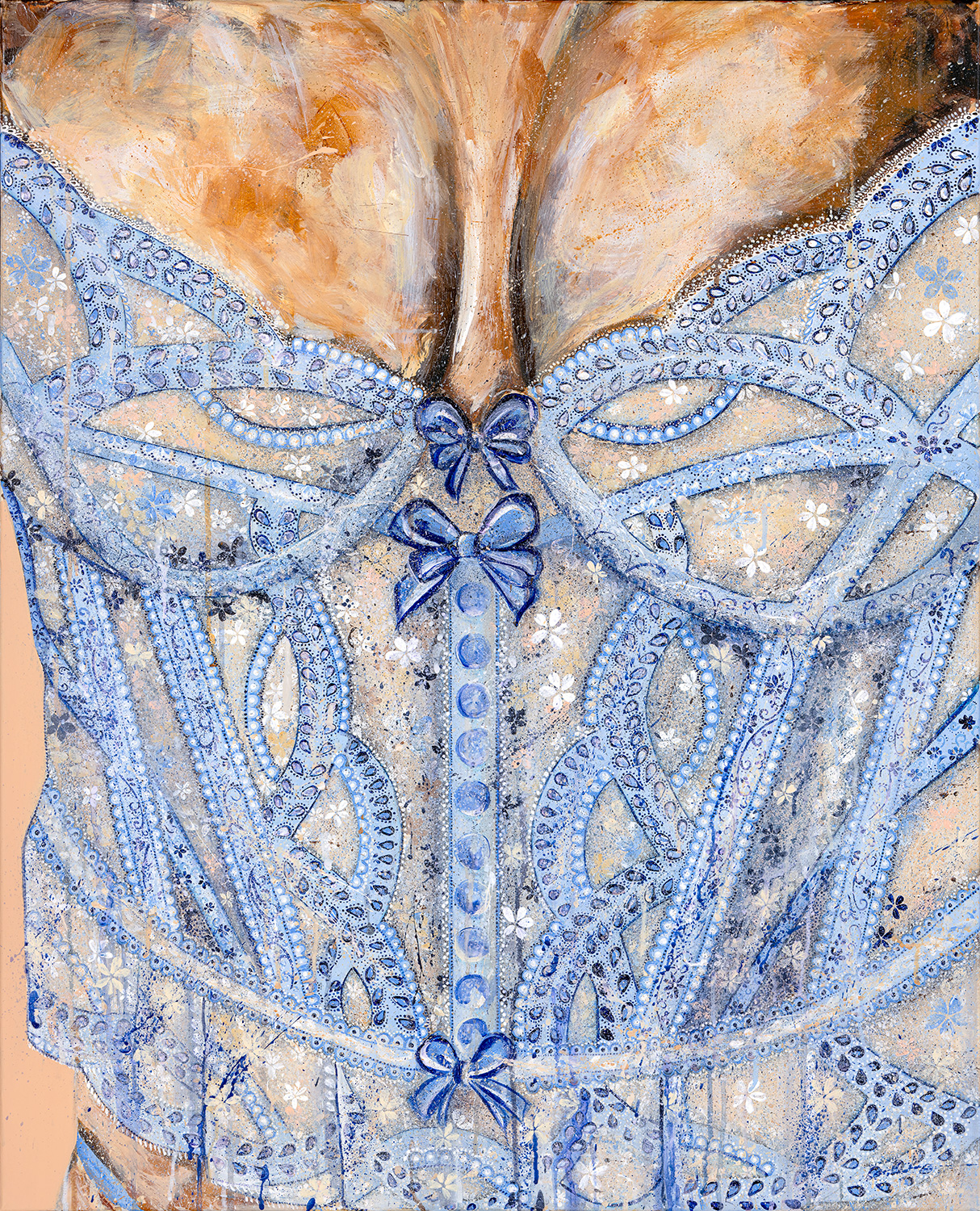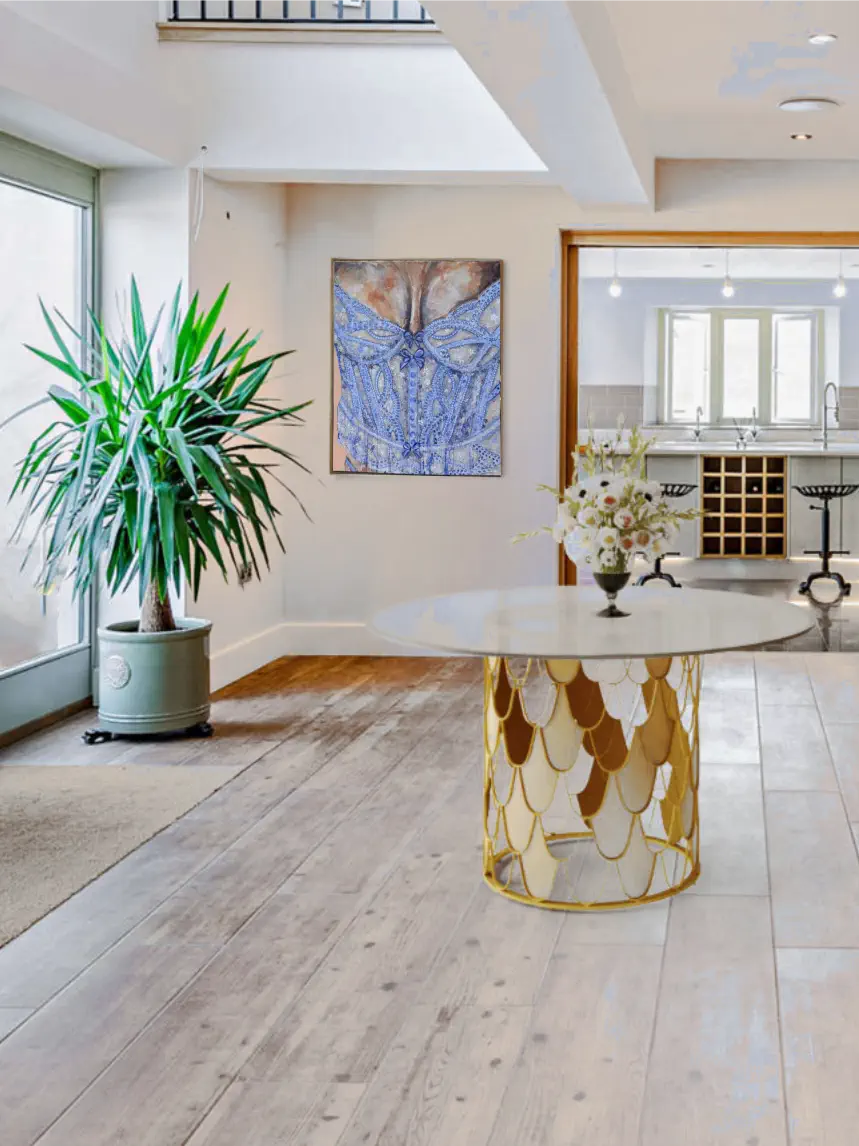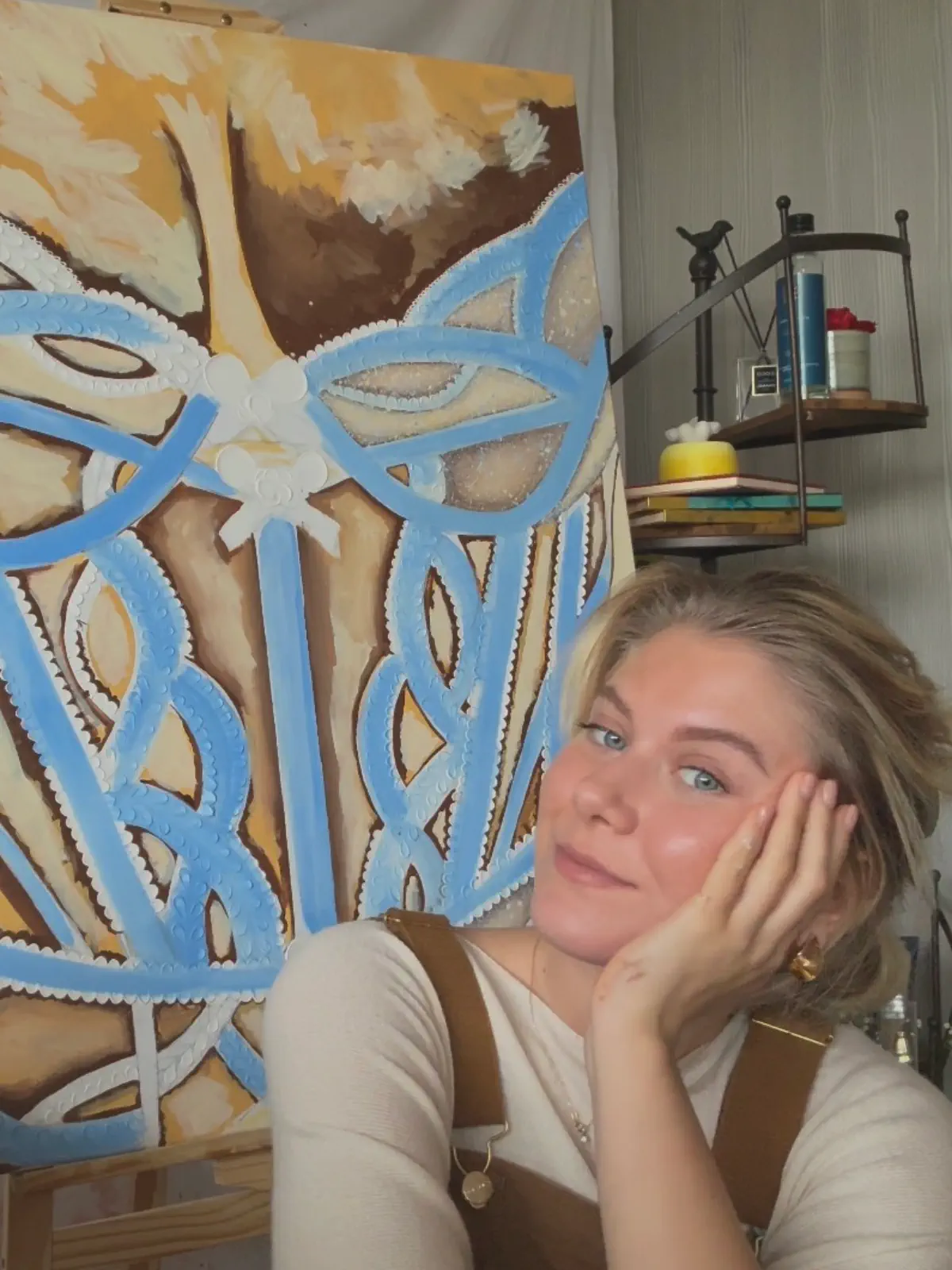Size: 39.5” x 32”
Medium: Acrylic paint and paste on canvas
Display recommendations
This painting’s soothing colours and tranquil energy make it ideal for spaces such as bedrooms, where the viewer can pause and reflect in solitude. It would also be effective in spaces meant for meditation or self-reflection, offering a calming atmosphere. Positioning it in a quiet corner, where one can sit and engage with the artwork thoughtfully, will enhance the emotional connection it fosters. To emphasise the introspective quality of the artwork, consider displaying it in a room with soft, natural lighting that complements the serene tones of the painting.
Delicate Armour
Mirroring the ebb and flow of healing, the corset acts as a metaphor for emotional walls built in response to trauma
The story behind the artwork
Delicate Armour immerses the viewer in the serene elegance of a woman’s corset, delicately rendered in soft light blue hues. The work evokes a sense of sophistication, with its colour palette inspired by the tranquil shades of the Côte d’Azur. The painting captures the feeling of a peaceful lifestyle, mirroring the rhythm of the Southern French coast. It symbolises the quiet complexity of womanhood and the strength found in embracing vulnerability.
Visual elements
The contrast between the delicate structure of the corset and the dynamic acrylic paint splatters brings the piece to life. These random splatters of paint are fluid and dynamic, mimicking the ever-changing movement of the sea and sky, representing the emotional fluctuations of healing. The soft tones of blue dominate the composition, evoking feelings of peace and serenity, while the intricate curves and delicate details of the corset emphasise femininity and grace. The visual elements invite a personal, introspective experience, allowing the viewer to explore vulnerability.
The calming qualities of blue create a sense of emotional balance, often associated with clarity and healing. The gentle tones of blue help ease feelings of anxiety or stress, allowing individuals to engage with their emotions at their own pace. Blue fosters a sense of safety, echoed in the corset’s role as amour. The sea, both changing and consistent, represents the healing journey—fluid and ongoing, marked by moments of calm and emotional turbulence.
The painting serves as a reminder to embrace the ebb and flow of the emotional process. Healing is not linear, and the sea embodies both the raw intensity of anger and frustration and the emotional chaos that can arise in the aftermath of trauma. The sea is a place of power and destruction, mirroring the emotional turmoil survivors may feel when confronting the aftermath of their experiences. Anger, often a reaction to betrayal and powerlessness, may coexist with the desire to regain control. When acknowledged and processed, anger can also be a catalyst for growth.
Blue can also represent sadness—a natural response to the loss of innocence and the grief of what has been altered by trauma. Anger toward violation and injustice can coexist with the sadness of what has been lost, and both must be processed for healing to occur. The brushstrokes appear introspective, soft, and repetitive, symbolising the ongoing process of recovery.
Meaning and intent
Delicate Armour speaks to themes of vulnerability and self-expression. The corset, with its soft curves and intricate details, acts as a metaphor for inner strength. The work embodies the fragility that comes with vulnerability, symbolising both control and protection. The corset offers a sense of safety, acting as a barrier or boundary, providing security and a protection of privacy and autonomy.
This piece subtly reflects the evolving cultural conversation around women’s bodily rights and consent, highlighting the process of rebuilding and reclaiming power over one’s body. The corset represents the emotional walls survivors build as protective mechanisms against the fear of experiencing similar trauma again. These walls, while offering safety, can also prevent the survivor from embracing new connections and experiences, stemming from the fear that the past may resurface.
The corset becomes a defence mechanism, a way to prevent others from getting too close and potentially re-enacting past trauma or opening old wounds. However, this false sense of security emphasises the complex process of healing. Letting go of the corset represents finding a way to establish healthy boundaries, a movement towards self-empowerment that balances the need for protection with the desire for intimacy.
The flowers painted within the corset symbolise that, as survivors heal and regain their sense of self, they may come to realise that true strength lies not in rigid defences but in the ability to open up to others while remaining grounded in their own sense of self-worth. Survivors have the power to define their own identities and boundaries, allowing both protection and connection to coexist.
Display recommendations
This painting’s soothing colours and tranquil energy make it ideal for spaces such as bedrooms, where the viewer can pause and reflect in solitude. It would also be effective in spaces meant for meditation or self-reflection, offering a calming atmosphere. Positioning it in a quiet corner, where one can sit and engage with the artwork thoughtfully, will enhance the emotional connection it fosters. To emphasise the introspective quality of the artwork, consider displaying it in a room with soft, natural lighting that complements the serene tones of the painting.



